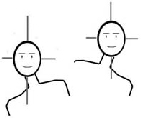
(Avatar Physics and Genetics)
4. Social Aspects
4.1 Intentional vs. Newtonian Motion
Physical simulation has become a common ingredient in many animated media and it has made a difference in the level of realism possible. But when modeling humans, it is not enough to build a human-shaped 3D object and simply to apply some Newtonian mechanics to its parts so that it moves according to physical laws. Humans do not roll down hills like spheres and they do not topple over passively when hit (unless they're dead). Humans, like all agile animals, have a way of overcoming many of the constraints of physics, transcending it, exhibiting motions and behaviors which can be complex, goal-directed, often linguistic in nature, and often opposing the laws of gravity (as in the finer moments of dance and sport). This is why inverse kinematics is such a useful technique for humans and animal animation: we have neuromuscular systems for positioning parts of our bodies in precise ways.
As part of a methodology for designing avatars, one might begin with the premise that the avatar is two things: 1) a physical object (obeying the laws of physics) and, 2) an intentional object (obeying the laws of biology, psychology, sociology, and culture). This is especially important since most avatars are instruments of expres-sion and communication within online worlds where community and communication rule.
4.2 Whatís in a Face?
An example of this principle in this implementation is the design of the face. The avatars described here are designed for optimal communication, expression, and individuality. Rather than consider the face as a physical surface made out of teeth, hair, and skin, the design of the face is approached from a visual expression point of view. To most of us, a face is a giver and taker of expression, and the locus of identity. It is a dynamic, expressive sign - an animated visual signal, possessing distinct visual elements which are evolved for message-giving, and message receiving. Faces are unique among objects in the universe which are perceived and responded to by humans. Not only are our eye/brain systems highly tuned to faces, but we tend to filter out noise in the background, where mouth, eye, head motion, etc., compromise the salient features to which we respond. For this reason, a face was developed which dedicates computation to the behaviors and geometry of mouths, eyes, and head motions.
These faces are dynamic, in that every avatarís expressive state from moment to moment can alter the geometry of the face, procedurally. In addition to this, individual genetics determines a great variety. For these reasons, a procedural head was designed, generated in software, along with the control functionality necessary for operation, instead of using a pre-existing model. Figure 6 shows four examples of facial expressions. The rendering style here uses flat shading and real time-computed silhouettes: outlines - basic ingredients in cartoon art. This rendering style eliminates most of the modeling aspects that are not relevant to expression, and may be a distraction.

Fig. 6. Some facial expressions
4.3 Head Orientation
One of the most salient indicators of sentience in animals is the orientation and rotation of the head. Looking and listening are often accompanied by orienting and re-orienting the head, as the animal moves through reality, encountering other animals along the way. Avatars in a social world must engage with each other, sometimes in flirtatious situations. To simulate the effect of aiming the head and gazing, a form of inverse-kinematics is applied to the head, except, unlike most inverse-kinematic techniques, which simulate physical forces as applied to articulated bodies, this one simulates a psychological force.
To create an upright position of the head, under normal conditions, a head gyroscope is applied: while the head can turn (or "yaw", rotating around the global vertical axis), the head cannot tilt forward or from side to side as a result of the neck (its parent part) rotating. This breaks the parent-child constraint of hierarchical modeling. Essentially, this means that unless the avatar is specifically rotating its head as part of an expression or a gaze, the head remains upright, its up vector always pointing in the global up direction, as illustrated in Figure 7.

Fig. 7. The head gyroscope makes avatars look more alive
I remember when I implemented this simple constraint. Many people noticed a marked difference, noting that the avatars seemed more alive, although they could not say why.
5. Visualization
